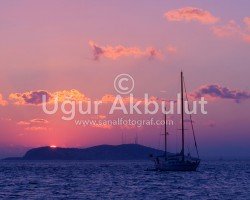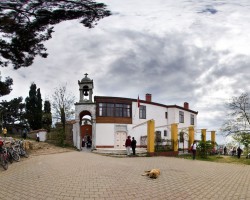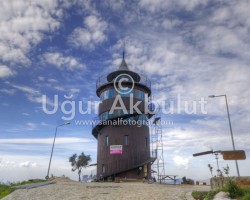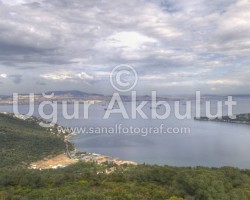[pano file=”https://www.sanalfotograf.com/ugurakbulut/adakule-tepeden-genel-gorunum.swf” width=”100%” height=”556″]
| Büyükada, yabancılar tarafından Prens Adaları olarak da bilinen İstanbul açıklarındaki adaların en büyüğüdür. Eski Yunanca adı Πρίγκηπος Prinkipos’dur. Prinkipos Yunanca’da Prens anlamına gelmektedir.
Coğrafya Tarihçe Tarihi yapılar İsa Tepesi’nde ise Hristos kilise ve manastırı ile Rum Yetimhanesi bulunmaktadır. Rum Yetimhanesi’nin binası harabe olmasına rağmen halen dünyanın en büyük ahşap monoblok yapılarındandır. Kumsal semtindeki Ayios Dimitrios kilisesi de Büyükada’nın önemli dini yapılarındandır. Adadaki çok küçük Ortodoks cemaat, büyük ayinlerini burada yapar. Büyükada’da bulunan 4 camiden mimari bakımdan en dikkat çekeni 2. Abdülhamid tarafından yaptırılan Hamidiye Camii’dir. Mimari açıdan Batı etkisinde inşa edilmiş bulunan mekan, Ada Cami Sokağı’nda bulunmaktadır. Turizm Denize girmek isteyenler için dört plajı mevcuttur: * Yörükali Plajı Lev Troçki’nin, Gürcü asıllı Sovyet lideri Stalin tarafından sürgün edildikten sonra 1929-1933 yılları arasında yaşadığı Nizam Mahallesi’ndeki ev ve ünlü yazar Reşat Nuri Güntekin’in Maden Mahallesi’ndeki evi adayı ziyaret edenlerin ilgisini çekmektedir. Aya Yorgi manastır ve kilisesinin özel bir yeri vardır: Her yıl 23 Nisan ve 24 Eylül günlerinde sayısız insanın 200 metrelik bu tepeyi tırmanıp kiliseye ulaşınca, inancı doğrultusunda dua ettiği, niyet tuttuğu ya da şifa umuduyla siyah cüppeli bir Ortodoks papazdan dua dilediği görülebilir. “Büyükada.” Wikipedia, Özgür Ansiklopedi. 24 Ock 2010, 19:56 UTC. 24 Ock 2010, 23:22 <http://tr.wikipedia.org/w/index.php?title=B%C3%BCy%C3%BCkada&oldid=7081087>.———————————————————————————————————————————————————————— ENGLISH Büyükada (meaning “Big Island” in Turkish; Greek: Πρίγκηπος or Πρίγκιπος, pr. Pringipos: in some cases Pringipo; and alternatively Πρίγκηψ or Πρίγκιψ (pr. Pringips) meaning “Prince” or “Foremost”) is the largest of the nine so-called Princes’ Islands in the Sea of Marmara, near Istanbul. It is officially a neighbourhood in the Adalar district of Istanbul, Turkey. As on the other islands, motorized vehicles – except service vehicles – are forbidden, so visitors explore the island by foot, bicycle, in horse-drawn carriages, or by riding donkeys. A convent on Büyükada was the place of exile for the Byzantine empresses Irene, Euphrosyne, Theophano, Zoe and Anna Dalassena. After his deportation from the Soviet Union in February 1929, Leon Trotsky also stayed for four years on Büyükada, his first station in exile. Princess Fahrelnissa Zeid was born in the island. There are several historical buildings on Büyükada, such as the Ayia Yorgi Church and Monastery dating back to the 6th century, the Ayios Dimitrios Church, and the Hamidiye Mosque built by Abdul Hamid II. Büyükada consists of two peaks. The one nearest to the iskele (ferry landing), İsa Tepesi (meaning Jesus Hill in Turkish), formerly Hristos (Χριστός, the Greek name for Jesus Christ), is topped by the former Greek Orphanage, a huge wooden building now in decay. In the valley between the two hills sit the church and monastery of Ayios Nikolaos and a former fairground called Luna Park. Visitors can take the ‘small tour’ of the island by buggy, leading to this point, from where it is a strenuous climb to Ayia Yorgi, a tiny church with a cafe on the grounds serving wine, chips and sausage sandwiches, this being part of the “classic” Ayia Yorgi (St. George, in Greek Άγιος Γεώργιος) experience. Wikipedia contributors. “Büyükada.” Wikipedia, The Free Encyclopedia. Wikipedia, The Free Encyclopedia, 18 Jun. 2010. Web. 7 Jul. 2010. |
|





Henüz yorum yapılmamış